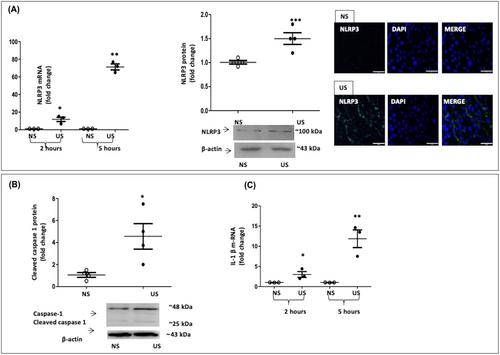A Toll-like receptor-4/NLRP3 inflammasome pathway promotes inflammation in skeletal muscle of chronic kidney disease patients
Abstract
Background
An emerging hypothesis is that the activation of innate immunity in the muscle of patients with chronic kidney disease (CKD) is implicated in the development and progression of wasting and cachexia. We previously observed that Toll-like receptor-4 (TLR4) and its downward NF-κB-dependent pro-inflammatory pathways are activated in CKD muscle. It is however unknown if TLR4 can activate the TLR4/NOD, LRR, and pyrin domain-containing protein 3 (NLRP3) inflammasome pathway, which is implicated in cardiovascular disease and frailty, clinical settings that are commonly observed in CKD patients.
Methods
In a case–control cohort study, we hypothesized that a TLR4/NLRP3 inflammasome pathway is activated in skeletal muscle in uraemia. First, we studied the regulation TLR4/NLRP3/caspase-1 in skeletal muscle biopsies (20M/11F) obtained from 31 non-diabetic CKD5 patients (eGFR 8 ± 1 mL/min 1.73 m2) scheduled for peritoneal dialysis catheter insertion and 15 controls (10M/5F, eGFR 99 ± 6 mL/min 1.73 m2). Second, the effects of uraemic serum on the TLR4/NLRP3 inflammasome pathway were studied in C2C12 cells.
Results
In the muscle of CKD subjects, NLRP3 mRNA as well as its protein were overexpressed (by ~16-fold, respectively, P < 0.05 both vs. controls). Both IL-1β and IL-18 mRNA expressions were also up-regulated (~11.8–3.2-fold, respectively, P < 0.05). Also, cleaved caspase-1 was overexpressed in CKD muscle samples (P < 0.001 vs. controls). Both muscle NLRP3 mRNA (n = 22, r = −0.606, P < 0.01) and logIL-1 β protein (n = 26, r = −0.460, P < 0.02) were inversely associated with residual renal function, which suggests that the inflammasome is progressively activated in skeletal muscle of CKD patients as the residual renal function deteriorates. In addition, we observed that in C2C12 myotubes, uraemic serum up-regulates NLRP3 mRNA (~11-fold increase, P < 0.05), cleaved caspase-1 (by ~5-fold, P < 0.05), Il-1β mRNA (~3-fold increase, P < 0.05) and oxidative stress markers respect to normal serum. These effects were prevented by TAK-242, a selective TLR4 inhibitor.
Conclusions
Overall, our data demonstrate the activation of TLR4/NLRP3/caspase-1 inflammasome and its downward inflammatory cascade in the muscle of subjects with advanced-stage CKD and suggest targeting TLR4/NLRP3 inflammasome as a new therapeutic strategy to blunt muscle inflammation in CKD.


 求助内容:
求助内容: 应助结果提醒方式:
应助结果提醒方式:


